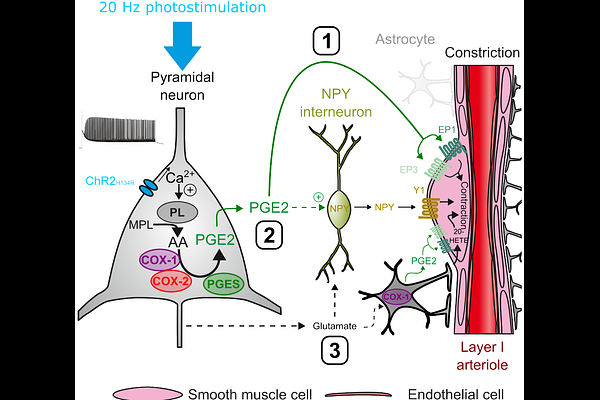Elevated pyramidal cell firing orchestrates arteriolar vasoconstriction through COX-2-derived prostaglandin E2 signaling

Elevated pyramidal cell firing orchestrates arteriolar vasoconstriction through COX-2-derived prostaglandin E2 signaling
Le Gac, B.; Tournissac, M.; Belzic, E.; Picaud, S.; Dusart, I.; Soula, H.; Li, D.; Charpak, S.; Cauli, B.
AbstractNeurovascular coupling (NVC), linking neuronal activity to cerebral blood flow (CBF), is essential for brain function and underpins functional brain imaging. Whereas mechanisms involved in vasodilation are well-documented, those controlling vasoconstriction remain overlooked. This study unravels the mechanisms by which pyramidal cells elicit arteriole vasoconstriction. Using patch-clamp recording, vascular and Ca2+ imaging in Emx1-Cre;Ai32 mouse cortical slices, we show that strong optogenetic activation of layer II/III pyramidal cells induces arteriole vasoconstriction, correlating with firing frequency and somatic Ca2+ increase. Ex vivo and in vivo pharmacological investigations indicate that this neurogenic vasoconstriction extends beyond glutamatergic transmission and predominantly recruits prostaglandin E2 (PGE2) through the cyclooxygenase-2 (COX-2) pathway, and activation of EP1 and EP3 receptors. Single-cell RT-PCR further identifies layer II/III pyramidal cells as a key source of COX-2-derived PGE2. Additionally, we present evidence that specific neuropeptide Y (NPY) interneurons acting on Y1 receptor, and astrocytes, through 20-hydroxyeicosatetraenoic acid (20-HETE) and COX-1-derived PGE2, contribute to this process. By revealing the mechanisms by which the activity of pyramidal cells leads to vasoconstriction, our findings shed light on the complex regulation of CBF.